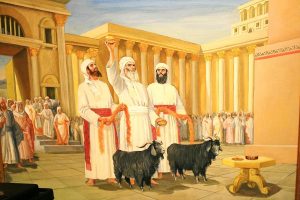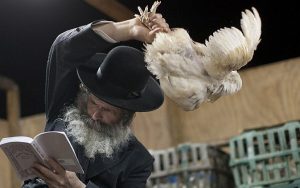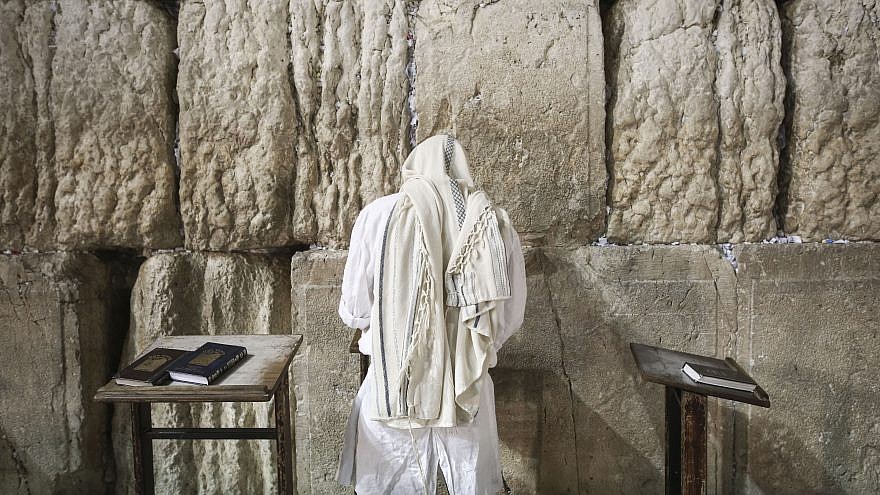Chickens, Goats, Fish, the Lottery, and Yom Kippur + The Annual Michila (Forgiveness) Form:
Tonight is Erev Yom Kippur and by tomorrow night this time, most of you will (still) be in shul listening to the rabbi’s Kol Nidrei speech which almost always includes an appeal for money. Our sages of yore, and our rabbis of today, have convinced us that we have improved odds of appeasing the RBSO for our indiscretions in this past year if we but respond and give generously to the shul. No matter what your sin was, or where committed, responding to the Kol Nidrei appeal –so they tell us- gives us a fighting chance. So happens they don’t remind us that our liturgy calls for a combination of tfilah, tzedooko and repentance (prayer, charity, and repentance) -in some magical combination, one we don’t have the answer to- in order to unseal and vacate any deleterious verdict against us.
Does pledging money to the shul on Yom Kippur eve mamish get us a pass? Is the RBSO open to our bribes of charity? Can we buy our way out? Is there another way? Seemingly there are a few, and this year we shall take a short look at a few other tricks in our receptive tshuva armamentariums; they are –according to some but zicher not all- tools of the trade in order to help us help the RBSO go easy on us. And they include chickens, goats -as in more than one- and even a fish, a very big one. Seemingly, they all play some role in our tshuva efforts. How, what, when, why and where? What’s pshat. And just how are these species involved in our Yom Kippur lives and rituals? Let’s find out.
 And the above listed have just what in common? One is prominently featured in the days leading up to Yom Kippur, while goats and fish are featured on Yom Kippur mamish. What are chickens –rooster, and or, hens- doing in our pre Yom Kippur service? What is the role of the goat and of the fish? How did they get entangled with our lives, and what role do they play in helping us seek forgiveness from the RBSO for our egregious behavior in the past year? We shall look at them shortly, ober ershtens a few words about the lottery. The lottery!? Indeed. The lottery too has a role to play.
And the above listed have just what in common? One is prominently featured in the days leading up to Yom Kippur, while goats and fish are featured on Yom Kippur mamish. What are chickens –rooster, and or, hens- doing in our pre Yom Kippur service? What is the role of the goat and of the fish? How did they get entangled with our lives, and what role do they play in helping us seek forgiveness from the RBSO for our egregious behavior in the past year? We shall look at them shortly, ober ershtens a few words about the lottery. The lottery!? Indeed. The lottery too has a role to play.
According to the Achroin Wikipedia, who seems to know just about as much as did Rashi bask in his time, in fiscal 2018, Americans alone spent $77.7 billion on various lotteries, up about $5 billion from 2017. That billions with a big B! A few more lottery facts: The first modern government-run US lottery was established in Puerto Rico in 1934. Decades later, in 1964, New Hampshire followed. Instant lottery tickets, also known as scratch cards, were introduced in the 1970 while lotto came about in 1988 mega millions came only in the last 23 years, on August 21, 2016. As of November 2018, lotteries are established in 45 states, the District of Columba, Puerto Rico, and the U. S. Virgin Islands and believe it or not, Mississippi finally legalized a lottery just about one year ago on October 19, 2018. Ticket sales for the Mississippi Lottery began only this year.
And before that? Historian Neal Millikan using newspaper advertisements in the colonial era, found that at least 392 lotteries were held in the 13 colonies. Yes in the colonies, not the bungalow colonies you or your parents and grandparents visit in the summer months. And before that? And the idea for a lottery care from where? From the RBSO in His heylige Toirah given in the year 2448. Let read the instructions. Says the heylige Toirah (Vayikro 16), azoy:
 “And he shall take from the congregation of the children of Israel two kids of the goats as a sin offering, and one ram as a burnt offering. Aharoin shall offer the bull as a sin offering, which is for himself, and make atonement for himself and for his house. He shall take the two goats and present them before the RBSO at the door of the tabernacle of meeting. Then Aharoin shall cast lots for the two goats: one lot for the RBSO and the other lot for the scapegoat. And Aharoin shall bring the goat on which the Lord’s lot fell, and offer it as a sin offering. But the goat on which the lot fell to be the scapegoat shall be presented alive before the RBSO, to make atonement upon it, and to let it go as the scapegoat into the wilderness.”
“And he shall take from the congregation of the children of Israel two kids of the goats as a sin offering, and one ram as a burnt offering. Aharoin shall offer the bull as a sin offering, which is for himself, and make atonement for himself and for his house. He shall take the two goats and present them before the RBSO at the door of the tabernacle of meeting. Then Aharoin shall cast lots for the two goats: one lot for the RBSO and the other lot for the scapegoat. And Aharoin shall bring the goat on which the Lord’s lot fell, and offer it as a sin offering. But the goat on which the lot fell to be the scapegoat shall be presented alive before the RBSO, to make atonement upon it, and to let it go as the scapegoat into the wilderness.”
The first drawing was held on Yom Kippur some 40 plus years later. Mamish? Indeed so; this lottery was mamish about life and death. Shoin: Let’s learn how chickens, goats and fish play significant roles in how we are graded and judged on Yom Kippur for the coming year.
Ober what is the connection between chickens, goats, fish and us and why are they involved in deciding what the coming year has in store for us? Let’s find out. And we begin with a somewhat difficult to comprehend ceremony known as kaporis. We have previously discussed this rather unusual ritual, one still practiced by many in the orthodox and chasidishe world. Bikitzur (in short): by waiving the chicken over our heads while reciting an introductory paragraph followed by these words “This is my exchange, my substitute, my atonement; this rooster (or hen) shall go to its death, but I shall go to a good, long life, and to peace.”
 We are hopeful of transferring our sins onto the chicken which gets nebech slaughtered. Exactly how this transfer takes place, ver veyst. Grada when the future Oisvorfer was a kid, we used to play this game called “Tag.” The object of the game is not to be it and the only way not to be it, is by tagging someone else, anyone else. When tagged, the next person becomes “it.” Fartig: no more it for you. Here are the rules in case you forgot: Tag is a playground game involving two or more players’ chasing other players in an attempt to “tag” or touch them, usually with a hand. As an aside, many wayward rebbes love this game! There are many variations; most forms have no teams, scores, or equipment. Usually when a person is tagged, the tagger says, “Tag, you’re ‘it’!”. The last one tagged during tag is “it” for the next round. And so it is seemingly with the chicken. Though you committed various sins –the list too long for these pages- by tagging the chicken, or in his case, by holding and waving it over your respective heads, you are no longer it. Your sins –including those for other chicken abuse, if you chap, are all transferred. The chicken is now it and shoin as they say “sholom al yisroel (peace onto the nation of Israel).
We are hopeful of transferring our sins onto the chicken which gets nebech slaughtered. Exactly how this transfer takes place, ver veyst. Grada when the future Oisvorfer was a kid, we used to play this game called “Tag.” The object of the game is not to be it and the only way not to be it, is by tagging someone else, anyone else. When tagged, the next person becomes “it.” Fartig: no more it for you. Here are the rules in case you forgot: Tag is a playground game involving two or more players’ chasing other players in an attempt to “tag” or touch them, usually with a hand. As an aside, many wayward rebbes love this game! There are many variations; most forms have no teams, scores, or equipment. Usually when a person is tagged, the tagger says, “Tag, you’re ‘it’!”. The last one tagged during tag is “it” for the next round. And so it is seemingly with the chicken. Though you committed various sins –the list too long for these pages- by tagging the chicken, or in his case, by holding and waving it over your respective heads, you are no longer it. Your sins –including those for other chicken abuse, if you chap, are all transferred. The chicken is now it and shoin as they say “sholom al yisroel (peace onto the nation of Israel).
Why the unsuspecting and innocent chicken is condemned to death while we live to commit new sins in the coming year, ver veyst. Is this form of chicken waving tshuva (repentance) described anywhere in the heylige Toirah? It is not? In the heylige Gemora? Also not? Who hatched the idea?
Seemingly, this custom was first discussed by Jewish scholars in the ninth century. Some explain azoy: the Hebrew word ‘gever’ means both “man” and “rooster,” therefore using a term we learned in geometry while studying angles, we employ substitution whereby the bird – because it’s suddenly it- gets punished by slaughter, while we are free to roam about the cabin so to speak, if you chap, for another year. Nu, everyone like a shtikel substitution once in a while and shoin: just like that, kaporis became an acceptable ritual.
Without getting into lengthy discussion about its origins and which rabbis and thought leaders were for and against the idea of waving and then slaughtering chickens as part of a repentance ritual, the bottom line is this: the custom, as is the case of kimat all other such hatched ideas, took root. It had, and continues to have followers ad hayoim hazeh (until today). Let’s all agree that supporters of the strange ritual, and those standing in opposition include a list of who’s who in recognized names, people whose books we study. The bottom line: Yiddin will try anything to find a scapegoat for their sins, and if waiving a chicken over their heads might get them a hall pas, many were, and remain all in. Nu, speaking of scapegoats and of the lottery mentioned above, let’s quickly look at the ultimate scapegoat.
Who gave birth to the word scapegoat and what does it mean? Informed sources tell us that a gentleman by the name of Tyndale coined the word scapegoat to describe the sin-bearing creature mentioned in the heylige Toirah when teaching us about the Yom Kippur service performed by the Koihen Godol (High Priest). He coined the word interpreting the Hebrew word azozel or Azozel as ez ozel, or “the goat that departs or escapes.” In the heylige Toirah, a scapegoat is an animal that is ritually burdened with the sins of others, and then driven away, or escorted a bunch of miles outside the city where it is thrown off a cliff to its death. The goat is designated to be cast into the desert to carry away the sins of the community. Nu, a strong back it zicher needed.
Says the heylige Gemora (Yoma 6:4, 67b), azoy: the etymology of azozel is a compound of az, strong or rough, and el, mighty, meaning the selected goat –by lottery- was sent from the most rugged or strongest of mountains. As an aside, the term azozel was also seen by a number of rabbinical commentators as the name of a Hebrew demon, angelic force, or pagan deity. Ober that for another time. The bottom line: who and what azozel was or is, remains in dispute. Another bottom line: On Yom Kippur, it was the Koihen Godol’s job to make use of the azozel goat to rid the Yiddin of their sins. Yet another chance the RBSO gave us to get back on track.
As to the koihen godol’s own sins –and which koihen among us –in fact, which person among us- is without some sin- well, once a year, also on Yom Kippur mamish, he brought a bull as his korban chatos (sin offering) to atone for sins he may have committed unintentionally throughout the year. What sins could such a holy man commit? If the high priest has a wet dream the night before Yom Kippur, he can’t lead the Day of Atonement rites and all of Israel will be damned. That is why, as the heylige Gemora tells us, he may not sleep the night before. To ensure this, tradition has it that the high priest would teach Toirah all night, and if he wasn’t knowledgeable enough to do this – which would apparently happen from time to time – Toirah would be taught to him. The Gemora continues: were the koihen to become extremely sleepy, and who among us hasn’t instantly fallen asleep when learning some Gemora or even Toirah, his bare feet would be placed on the cold floor of the Beis Hamikdash (Temple). Assuming he was dry in the morning, only then did he use the lottery system to select from the goats and confess the sins of the greater Jewish community . Thank the RBSO, the azozel carried and atoned for the sins we committed intentionally.
The tradition tells us that during the Second Temple period these two goats had to be purchased at the same time and for the same price: they had to be almost identical in appearance and value. After the lots were cast to determine which goat would play which role, a crimson thread would be tied around a horn of the goat that was to be escorted to the wilderness. Then, half of this thread was removed before the animal was sent away. Why?
Some say this complicated ceremony, as described in the heylige Gemora, involves the appeasing of a demon by the name of Azozel, ober that for another day. Whatever its purpose, the ceremony included a red band which was tied to this unfortunate goat’s horns before he was taken by another man – usually a priest – to the Judean Desert. Jerusalem notables accompanied the man and goat on their 12-kilometer trek. They ritualistically halted for refreshment at 10 huts specially erected for this purpose, where food and drink were ceremoniously offered the man, who would refuse it. Nu, making kiddish is always important. The goat’s preferences were apparently not considered. After the 10th booth, the man and beast proceeded alone. When they arrived at the top of a cliff face, the man would hoist the goat into the air and toss him down the hill backwards. The goat would tumble down the hill and die, at which point a system of flag signals would inform the high priest that he could continue with the rest of the day’s rituals.
 The bottom line: while some might find the fates of both goats troubling, avada there are depths to Jewish rituals. What they are ver veyst? Who says we need to chap everything we do? We should –at times- be limiting our chapping, if you chap. If the RBSO gave us yet another key to getting off, avada we must chap it. And if all that weren’t enough to spur you on to confess your sons and set you on the right path, and avada it should be, our rabbis have us read the story of Yona (Jona) in its entirety and how he was swallowed by a great big whale, survived there for three days before being spit out alive.
The bottom line: while some might find the fates of both goats troubling, avada there are depths to Jewish rituals. What they are ver veyst? Who says we need to chap everything we do? We should –at times- be limiting our chapping, if you chap. If the RBSO gave us yet another key to getting off, avada we must chap it. And if all that weren’t enough to spur you on to confess your sons and set you on the right path, and avada it should be, our rabbis have us read the story of Yona (Jona) in its entirety and how he was swallowed by a great big whale, survived there for three days before being spit out alive.
Why do we read Yona of all things on Yom Kippur? There are better tales of tshuva that are more relevant to klall Yisroel; why was this sefer, which deals exclusively with non-Jews doing tshuva, chosen instead? A few reasons are proffered: grada the Oisvorfer recalls learning and taka found this same answer in a sefer called Tzeidah Laderech which says azoy: if even the goyim of Ninvey could be forgiven with tshuva, al achas kamma vo’kamma (of course and avada), the RBSO will surely forgive us Yiddin who already has a bris literally and with the RBSO. Another flavor from the Chofetz Chaim (Shaar Hatziyon 622:6): we read Yona to learn that one cannot flee from the RBSO. One more: from the fact that the ship was in danger of sinking because of an individual’s wrongdoing, we learn that one can endure suffering for others. Some say that the death and suffering of tzadikim (very righteous people) atones for others. Let’s recall the deaths of Nodov and Avihu. Who was Yona? Sassy the Novee (Milochim1 17:17-24) that Yonah ben Amitai was the child of the widow who sustained Eliyahu. Yonah died and Eliyahu revived him from the dead. Bottom line: why do we read Yona on Yom Kippur? Efsher because it features a fish; hec, if the chicken and goats have a role in helping clean our slates, why not a whale? Also, the long haftorah gives those who overslept a chance to get back for the final prayer of the day.
And the real bottom line: the entire lottery system has been suspended –at least until the Moshaich makes an appearance and the koihen godol can no longer rid you of your sins Moreover, no matter how many chickens you wave over your head and no matter how shaken you are to your core when you read the sorry of Yona and the big fish, Yom Kippur does not atone –in any way shape or form- for sins you may have –read: did) commit against your fellow man. For those, you need to personally reach out to those you may angered, upset and even pissed off. Ober for most of you, the list it too long and mistama you are embarrassed and otherwise not comfortable confessing the myriad sins you committed against your friend and even neighbor. Nu, thankfully the RBSO allowed Al Gore to invent the Internet and now through email or by text, you have the opportunity to reach out and clean the slate. How: by reading carefully the Oisvorfer’s Michila form –it works as does most other forms our rabbis have developed in the loophole department and may just get you the proper forgives you nearly need to clean your slates. Wishing you all a g’mar chasima toiva – May the RBSO seal your fate for the good.
Use this form to ask for forgiveness:
PRE YOM KIPPUR MICHILA (FORGIVENESS FORM):
WHO SHOULD USE THIS FORM:
I: SPEAKERS AND FACILITATORS OF LOSHOIN HORO AND OR RICHILUS
II: CAN ALSO BE USED TO SAY I’M SORRY TO ANYONE ELSE YOU PISSED OFF DURING THE PAST YEAR OR EVEN YEARS, INTENTIONALLY OR NOT.
III: MAY –AT YOUR OWN RISK- ALSO BE USED IN LIEU OF FLOWERS AND OR JEWELRY BETWEEN HUSBANDS AND WIVES, PREFERABLY YOUR OWN!
COMPLETE ALL FIELDS
1- Sinner’s Name (you!)____________________________
2- Sinner’s Cell # (yours)___________________________
3- Sinner’s email address (List all email addresses used during the past 12 months to bad-mouth a friend, relative, business partner and including those you barely know____________________________________________________________
4-To: ____________________________(List person(s) you aggrieved and from whom you seek forgiveness). Use a new form for each recipient. Use extra sheets if necessary.
5- What I specifically said or wrote about you. Attach copies of any and all emails, text messages, and anything that you wrote, exchanged and or forwarded about another friend, relative and others, here___________________
5a- I also want you to know that I Googled you mercilessly and then took great delight in forwarding any and all schmutz to all on my email list.
6- Check appropriate box: How many times I bad mouthed you in the past year: 1-5 6-10 weekly whenever the opportunity presented_____________ whenever your name came up in regular conversation____________.
7- I am sorry!
8- Get over it! You would’ve or did the same to many others. Mistama we are even!
9- We are in this together.
10- I am willing to forgive you if you forgive me. Shoin!
11- Notwithstanding that some of, or most of what I may have said, or repeated, is emes (true), and though I am definitely guilty as charged for being the conduit for others reading, receiving and then further forwarding the schmutz I dug up on you, and though I mamish had fun at your expense, though I mamish did bad, I beseech you and ask that you offer me michila (forgiveness) in order that the RBSO will go easy on me.
12- Are you moichel me?
13- Why should you consider my request and offer complete forgiveness? Because it’s likely the case that you did the same: you too are guilty as sin of disseminating loshoin horo. Don’t be walking around like a victim! If you don’t forgive me, you are nothing but a hypocrite and the RBSO should punish you severely. Moreover, I will tell everyone on my email list that you are bad!
14- Thank you
15- Sincerely or not,
16-Signature______________________
17 Notarized______________________
Wishing you all a Gemar Tov and an easy fast-
The Heylige Oisvorfer Ruv
Yitz Grossman


